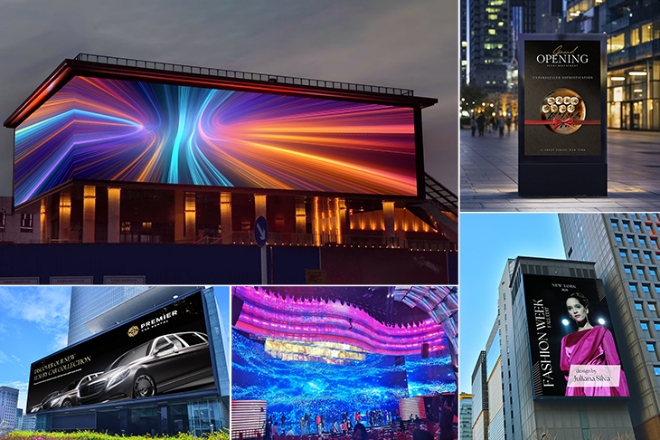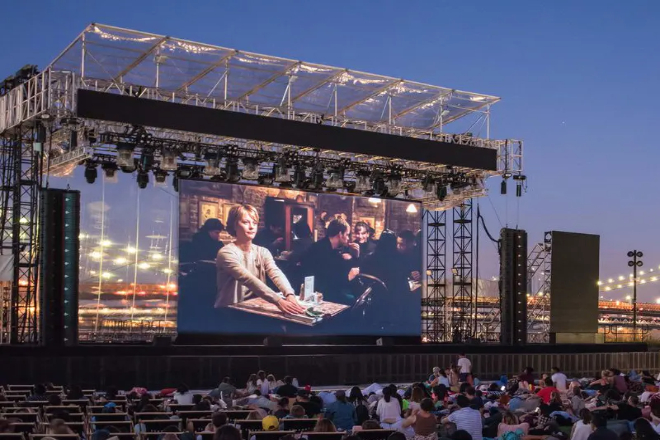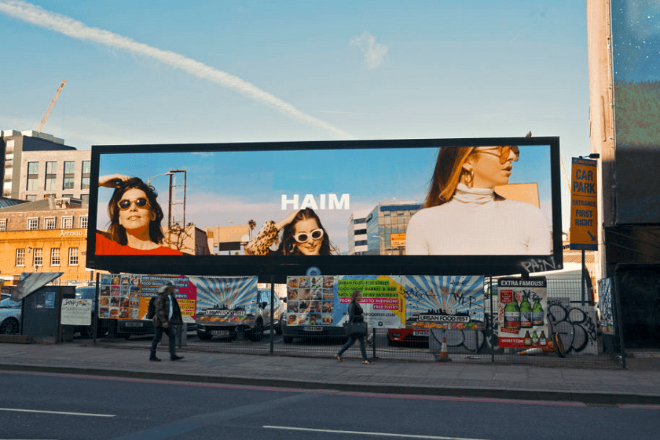Introduction

In LED display screens, especially outdoor LED display screens, almost all the time, both day and night, are working. But we also know that the light intensity during the day and night is different.
In order to meet the display needs in different time periods and environments, the day and night dual mode came into being and became an important function of LED display screens. So, how to use LED screens to achieve day and night dual mode?
Table of Contents
1. What technical foundations are needed for the day and night dual mode of LED screens?
If you want to achieve the day and night dual mode of LED screens, the light sensor is one of the most important components.
The light sensor is like a small “eye” that can sense the light around it. When it’s day, it tells the display screen: “Hey, it’s day, the display screen has to be brighter!”
Then, the LED display screen becomes brighter. When it’s dark, it says: “Hey, it’s dark, the display screen has to be darker!” Then, the LED display screen becomes darker.
When choosing a light sensor, you have to choose one that is particularly sensitive so that it can accurately sense the changes in light.
You also have to choose the one that reacts very quickly, so that the display screen can be brightened or dimmed immediately when it gets light or dark.
Of course, the sensor must be stable and cannot be sometimes effective and sometimes not.
Of course, in addition to the light sensor, two technologies must be used to achieve the dual mode of LED screen day and night:
1). Brightness adjustment technology
Brightness adjustment technology is like a “dimmer” for the display screen. When it gets light, it brightens the display screen so that everyone can see more clearly. When it gets dark, it dims the display screen a little, which saves power and is not dazzling.
This “dimmer” is also very smart. It can automatically adjust the brightness of the display screen according to the light outside. For example, when it is just a little dark, it slowly dims the display screen.
When it is completely dark, it dims the display screen even more. In this way, when everyone looks at the display screen, their eyes will be very comfortable.
Moreover, this “dimmer” can also remember everyone’s preferences. For example, some people like brighter colours, and some people like darker colours. It can adjust the brightness of the display screen according to everyone’s preferences.
2). Color correction technology
Colour correction technology is like a “makeup artist” for the display screen. Sometimes, because the light outside changes, the colour on the display screen will look a little wrong.
At this time, the “makeup artist” will take action to adjust the colour on the display screen back so that the colour you see is still as beautiful as before.
This “makeup artist” is also very powerful. It can automatically adjust the colour of the display screen according to the light outside.
For example, when it is dawn, it will adjust the colour on the display screen to be brighter; when it is dark, it will adjust the colour on the display screen to be softer. I
n this way, when everyone looks at the display screen, they will feel very comfortable and real.
In addition, this “makeup artist” can also consider everyone’s viewing habits. For example, some people like bright colours, and some people like soft colours. It can adjust the colour of the display screen according to everyone’s preferences.
In general, the realization of day and night dual mode is inseparable from the support of key technologies such as light sensors, brightness adjustment technology and colour correction technology.
They are like a team, working together to make the LED display screen show the best effect in different environments.
2. What are the ways to implement day and night dual mode?

1). Automatic switching method
The automatic switching method is actually like installing a “smart glasses” on your LED display. This “smart glasses” is a light sensor, which keeps an eye on the changes in the surrounding light.
- Light sensor signal acquisition:
When the sun sets and the sky gets darker, the light sensor “sees” it, and then it turns this change into an electrical signal to tell the control system: “Hey, it’s dark, it’s time to adjust the display!”
- Control system processing:
The control system immediately understands it, and it follows the pre-set rules, such as “lower the brightness and soften the color when it’s dark”, and then starts to figure out how to adjust the display.
- Display brightness and color adjustment:
The control system has figured out how to adjust it, and sends a command to the display: “Hey, display, it’s dark, you lower the brightness and soften the color.” The display immediately does it when it hears it.
1.1). Advantages:
- Intelligence:
This automatic switching method is like having a caring assistant who helps you keep an eye on environmental changes at all times without you having to worry about it.
- Convenience:
You don’t have to do anything, the display will adjust according to the environment, how convenient!
- Energy saving:
The brightness is lowered at night, electricity is saved, environmentally friendly and affordable.
1.2). Limitations:
- Response speed:
Sometimes, the weather changes too quickly, such as when it is suddenly covered with dark clouds, the display may not be able to keep up with the rhythm and be a little slower.
- Accuracy:
If the light sensor is covered by dust, water mist, etc., it may not be able to “see” accurately, and the adjustment will not be so accurate.
- Cost:
If you need to add a light sensor and control module, the cost of the display will go up.
2). Manual switching method
2.1). Operation steps and precautions:
The manual switching method is much simpler, just like adjusting the volume of a TV.
- Operation steps:
You walk to the display, find a button or remote control, and press a few times to switch to night mode or day mode. Some displays also have menus, you can go in and select.
- Note:
When switching, you have to look at the surrounding environment. Don’t turn the display to night mode in broad daylight, which looks very awkward. Also, don’t forget which mode you are in, or you will lose it in a while.
2.2). Application value:
The manual switching method is particularly useful at certain times. For example, if you are a photographer, you need the display to be particularly bright or particularly dark when taking pictures, so you can adjust it manually.
Or if you are a game player, you don’t want to be too bright when playing games at night, you can also manually switch to night mode.
2.3). Comparison of automatic switching and manual switching:
Speaking of it, automatic switching and manual switching are like two people with different personalities.
- Automatic switching:
It is like a careful housekeeper, always helping you keep an eye on environmental changes, so you don’t have to worry about it. But sometimes it may react slowly, or “see” it inaccurately, and you have to spend more money.
- Manual switching:
It is like a little brother who is always on call, and it will do whatever you ask it to do. Although you have to do it yourself, you can adjust it however you want, which is very flexible.
So what scenes are they suitable for?
- Automatic switching:
Suitable for large public places, such as billboards, display screens in shopping malls, and crowded places. No one can adjust it all the time, so automatic is fine.
- Manual switching:
Suitable for scenes that require special care, such as studios, game rooms, or your own home. You can adjust it however you want.
In general, automatic switching and manual switching have their advantages and disadvantages.
Which one to choose depends on your own needs and scenarios. If you want to be convenient and worry-free, then choose automatic; if you want to control everything yourself, then choose manual. It’s that simple!
3. How to design the display content of day and night dual modes?
1). Daytime display content design
During the day, everyone is busy, walking on the road or waiting in public places, and they all want to see the information they want quickly.
At this time, the display content must be direct, practical, and eye-catching enough to catch everyone’s attention.
1.1). Advertisements, information and other content suitable for daytime display:
Advertisements: Promote new products, limited-time discounts, etc., which are brief and clear, with bright colors, and can attract people at once.
Information: Weather forecasts, news briefs, and traffic information are the most practical. They are displayed clearly and everyone can understand them at a glance.
1.2). Layout and colour matching design skills for daytime display content:
Layout: Don’t make it too complicated. Just keep it simple. Put important information in the middle or on the top so that everyone can see it at a glance.
Color matching: When the light is good during the day, use contrasting colors, such as black and white, red and green, so that the information is more eye-catching.
Font selection: Choose a clear font with a moderate size, not too small or too large, just comfortable to read.
2). Nighttime display content design
At night, everyone relaxes, maybe resting at home or strolling outside. At this time, the display content should be softer, not too dazzling, so that everyone can get information in a relaxed and happy atmosphere.
2.1). Advertisements, information and other content suitable for nighttime display:
Advertisements: Put something light and interesting, such as movie trailers and game promotions. Be creative and use soft colours to make people feel better.
Information: Night news, horoscopes, and good night stories are all good. Display them warmly so that people can get information in a relaxed state.
2.2). Design skills for brightness adjustment and colour correction of nighttime display content:
Brightness adjustment: The light is dim at night, so the display brightness should be lowered to avoid dazzling people’s eyes. You can adjust the display settings or use a sunshade.
Colour correction: The colours should be softer and warmer at night, and don’t use colours that are too glaring or too cold. Adjust the colour settings of the display or use colour correction software.
Dynamic effects: You can add some dynamic effects at night, such as gradients, flashing, etc., to attract everyone’s attention. But don’t use too many, otherwise your eyes will be tired.
2.3). How to use dynamic effects to attract the audience’s attention:
Don’t use too much: Alittle bit of dynamic effects is enough. Don’t make it too complicated. Otherwise, everyone will be dazzled.
Match it with the content: The dynamic effect must match the content, highlight the key points, and guide everyone’s sight.
Consider the viewing environment: When using dynamic effects, you have to think about the light of the viewing environment and the distance of the audience to make the effect the best.
In general, the design of the display content of the day and night dual mode should consider the needs and characteristics of the viewer.
The layout, color, brightness, and dynamic effects must all be taken into consideration to make everyone watch comfortably and happily.
4. How about the energy-saving and environmental protection of the day and night dual mode?

Speaking of the energy-saving technology of LED display screens in day and night dual mode, it is actually quite interesting.
Do you know that it is like a smart assistant that automatically adjusts the brightness according to the light outside?
When the sun is strong during the day, the display screen is bright, allowing us to see clearly; at night, it automatically dims, which saves power and is not dazzling.
Another very practical function is the standby mode just like our mobile phones will automatically lock the screen when not in use, LED displays will also enter a low-power state during non-working hours, just like taking a nap, which can save a lot of electricity.
These energy-saving technologies have many benefits. First of all, of course, it saves electricity!
By properly adjusting the brightness and standby mode, the energy consumption of LED displays can be reduced a lot, and some can even save half of the electricity! In this way, the electricity bill is reduced and the wallet is a little fatter.
Moreover, these energy-saving technologies can also extend the life of the display.
Did you know that long-term high-brightness work will make the LED lamp beads tired quickly, just like we will get tired after working for a long time.
Therefore, by adjusting the brightness, the display can be more relaxed and used for a longer time.
Day and night dual mode not only saves money, but also protects the environment!
Think about it, saving electricity means reducing greenhouse gas emissions, which is very good for the earth’s environment. Just like we drive less and walk more, we are all reducing the burden on the earth.
So, the LED display in day and night dual mode is really energy-saving and environmentally friendly.
It not only saves us money but also contributes to the earth’s environment. In the future, when we choose a display screen, we can also look at this energy-saving and environmentally friendly one, so as to contribute to the earth!
5. Application scenarios of LED display screen with dual day and night modes
1). Commercial advertising field
This dual day and night mode LED display screen can really improve the advertising effect.
Think about it: everyone is busy during the day and may not have much time to look at the advertisement carefully.
At this time, concise and clear advertisements are most suitable. At night, everyone relaxes and has time to go shopping and see the surrounding scenery.
At this time, playing some vivid video advertisements can make everyone impressed, and may even stimulate the desire to buy!
Moreover, this display screen can also automatically adjust the content according to the time period, which is quite smart and can also attract more customers’ attention, making the commercial district more lively.
2). Public information release field
This LED display screen has many benefits in the field of public information release.
First of all, it can automatically adjust the display content and brightness according to different time periods to ensure that the information can be clearly conveyed to the public during the day and at night.
In this way, everyone can get the information they need anytime and anywhere, which is quite convenient. Moreover, this display screen can also enhance the image of the city.
Think about it: the display screens of those transportation hubs and government departments all use day and night dual mode, with good display effect and look quite high-tech, which adds a sense of modernity and technology to the city!
In general, the day and night dual mode LED display screen is very popular in the field of commercial advertising and public information release.
It can not only improve the advertising effect and information dissemination ability, but also make the city look more modern and technological.
In the future, the application scope of this display screen will definitely become wider and wider, bringing more convenience and surprises to our lives!
6. Future development trend of day and night dual mode LED display screen

1). Direction of technological innovation
1.1). Smarter light sensor:
Speaking of the future day and night dual mode LED display screen, it is definitely getting smarter. The light sensor is a big highlight, and it will become more “smart” in the future.
Most of the current sensors can only sense the intensity of light, but the future sensors are “fire eyes and golden eyes”, which can not only see the intensity of light but also distinguish whether it is natural light or light and even sense the colour temperature of light.
In this way, the display screen can automatically adjust the brightness and colour according to the actual situation of the ambient light, making it more comfortable for us to watch.
This technological innovation greatly improves the display effect. Think about it, whether it is day or night, the display screen can automatically adjust according to the ambient light, which will definitely look more natural and comfortable.
Moreover, this intelligent adjustment can also save electricity and extend the life of the display screen. Isn’t this killing two birds with one stone!
1.2). More efficient brightness adjustment technology:
Let’s talk about brightness adjustment technology. The current display screen brightness adjustment is sometimes a bit “sluggish”, but it will be different in the future.
The brightness adjustment speed of the future display screen is so fast, with a millisecond response. It may be adjusted as soon as you blink your eyes.
Moreover, the adjustment is more precise, and it can be as bright or dark as you want, completely according to your needs.
This technology is also very beneficial to reducing energy consumption. At night or when the light is dim, the display screen automatically dims, and electricity is saved.
Moreover, the life of the display screen is also longer, because it does not need to be so dazzling all the time, and the lamp beads are also much more “relaxed”.
2). Market application prospects
2.1). Expansion of emerging application scenarios:
The application scenarios of dual-mode LED display screens will become more and more extensive in the future. For example, in smart homes, you can have a display screen at home to display the schedule and weather during the day and turn it into a home theatre at night.
How cool! There are also new technologies such as virtual reality and augmented reality, and dual-mode display screens can also be used to make you have more fun!
2.2). Growth of market scale:
Speaking of market scale, it is definitely getting bigger and bigger. Now, commercial advertisements and public information releases use dual-mode display screens for day and night, and there will definitely be more in the future.
Moreover, once new technologies and new application scenarios come out, the market scale will rise like a balloon!
7. Conclusion
I believe you have also learned in detail how the day and night dual-mode LED display works.
The emergence of day and night dual-mode not only greatly improves the display effect and user experience of the LED display but also enhances its information dissemination ability, thereby improving the attractiveness of advertising and the efficiency of information transmission.
Finally, if you want to know more about LED displays, please get in touch with us.
